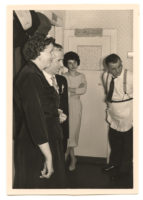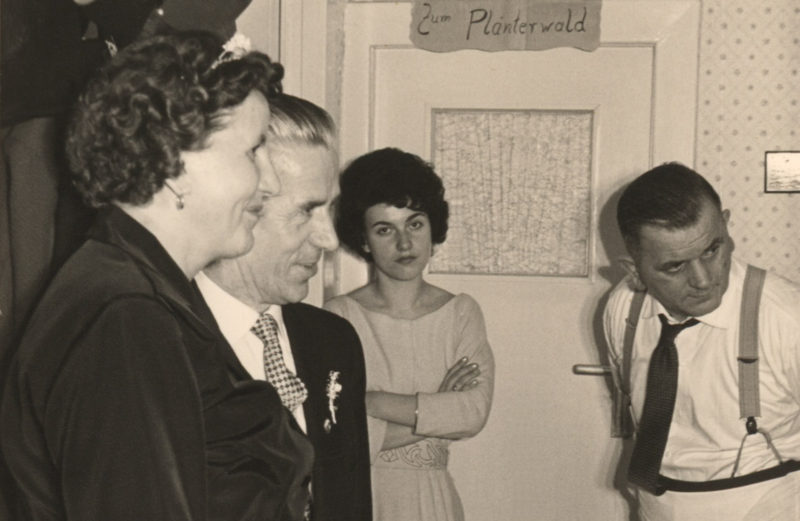I know nothing about this picture, other than what it is, literally is: a photograph I found in Berlin, browsing for pictures by way of rummaging through a huge box filled with photographs taken (where not ripped) from old albums.
Found photographs provide the litmus test for photography theories, given that in pretty much all cases we have no access to their makers’ intentions, ideas, theories, PR, you name it.
A lot of photography theory sounds really good, at least on paper (assuming, of course, it’s not the usual academic drivel, with terms taken from semi-nonsensical French philosophy thrown in for good measure). The same can probably be said for a lot of what one hears from photographers or critics. But when there’s just a photograph and nothing else, a photograph tied to nothing we have access to – what do we get from that? Crucially, do the theories still apply, given the absence of any additional information? Given we don’t know who took the picture and for what purpose and where…
This particular challenge posed by found photographs has me excited about them. On top of that, it does help that found photographs are essentially the only ones I can actually afford buying. But that’s of course a different issue.
Here then is a photograph I fell in love with immediately when I first saw it. In the strictest sense, the only things that matter for a photograph are those contained within its frame. Everything else is unknown, is unknowable. And this is certainly true here.
In some sense, whatever is outside of the frame matters in some way, given that all the people here are looking at it (or him or her). The two people on the left are looking at something or someone to the right of the frame, as does the man at the right edge. That man even has to make an effort looking at whatever it is that is the focus of most of the attention here, given he has to turn his body.
But the real kicker is the one person who is not only looking at that, but who is instead looking at the camera – and by the usual mental extension we make: at us, her arms crossed. She has had it. She’s fed up.
We got ourselves a game of looking here, which we, as the viewers, are becoming a part of. Photography is never more fun than when this happens. Portraits often are intriguing in all kinds of ways. But when we are seduced into thinking that we are in fact part of whatever is going on here, when we get the feeling we are essentially in the photographer’s place, then a portrait truly shines.

I should probably add a disclaimer now, given that most portraits fall just short of that, and that’s still fine for a lot of them. Plus, we all want different things from portraits. Maybe we’d rather be entertained (in which case the portrayed essentially clown around or pose for us). Or we’d rather not be in the position where the portrayed acknowledges the photographer’s (and, by psychological extension, our) presence. That’s all fine.
Back to the picture: the photographic reality is that we don’t actually know whether or not the woman was fed up. It’s impossible to tell.
I realized what photography can do – yet again – a little while ago when a masked gunman was holding hostages in a cafe in Australia. Occasionally, people would escape, and there would be photographs (widely circulated, for example this one) and video clips. What I noticed is that the visual expressions of the people in the photographs were almost impossible to make out in the videos.
We all know that photography does that. We just usually tend to ignore it (unless, of course, we’re looking at a picture of us that someone took, in which case a lot of the things we forget about when talking about pictures suddenly become very relevant).
So we don’t know anything about the mental state of that young woman. We’re tempted to infer things from what we see, because we treat the expressions of people in photographs in much the same way as in real life, the only difference being that the photographic ones are frozen forever.
And we do more. We also tend to think that our own experiences are somehow shared with those in the pictures, projecting what we know about ourselves onto (or maybe into) those whose picture we’re looking at. Chances are everybody has those irritating family moments, and how could one not assume (yes, assume, there’s no way of knowing) that it’s just that here in this picture?
We bring all of our own baggage to pictures, whether we’re merely viewers or critics or theorists, and often enough our thoughts around a picture are then made to conform to our agenda or ideology. Susan Sontag’s On Photography, for example, really says a lot more about her ideology than about photography – which is completely fine with me, as long as students required to read the text are not only being made aware of that, but are being asked to untangle things.
There’s nothing one can do about this essential human conundrum. We all view things from where we are, from what we know and, crucially, want. That said, though, I have found that most people who engage with photography on a regular basis but who are not part of what we could call photoland are often much more perceptive about the medium and what it does than many of the theorists. There’s no agenda to support.
There are the pictures, and given there are so many pictures all around us, we all know how to process them quite well, thank you very much. The only people who tie themselves into serious knots are those trying to make sense of photography.
Vernacular photographs, of which there exist so many, could maybe serve as the reminders that there is a world out there. Whatever we decide to think about photography, whether in MFA class rooms, in white cubes, or wherever else – it has to serve all photographs, not just those in the particular environments we’re in. And given vernacular photographs come in an almost primordial form, without any theories or explanations or PR attached already, they are the ones we should be looking at first when theorizing.
